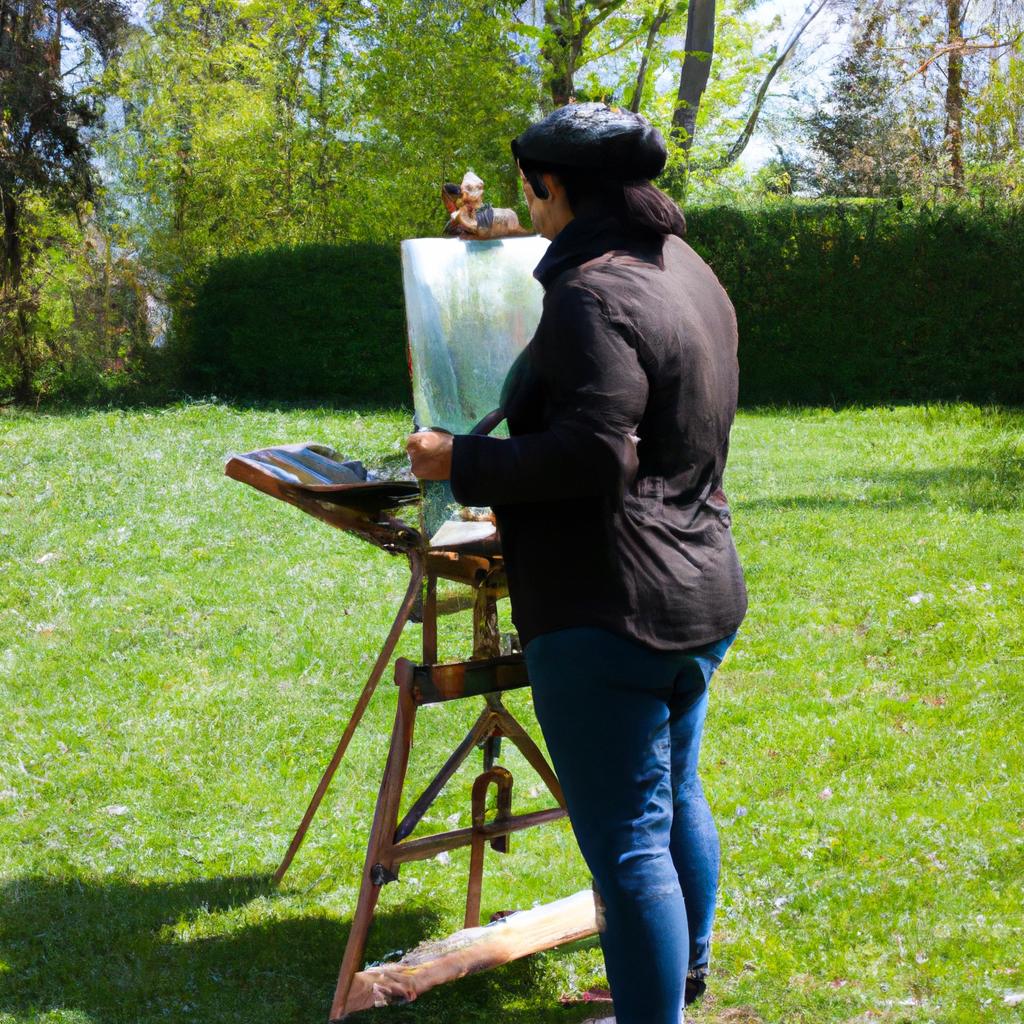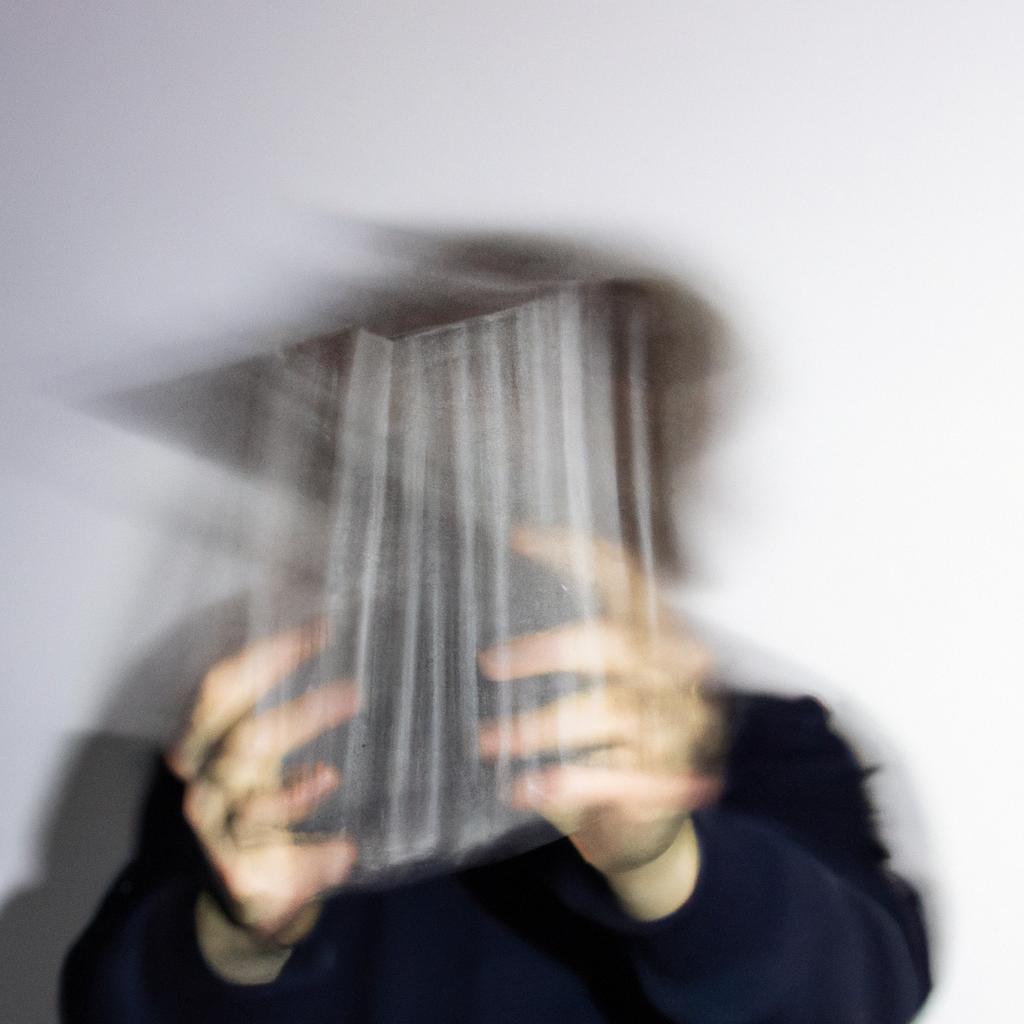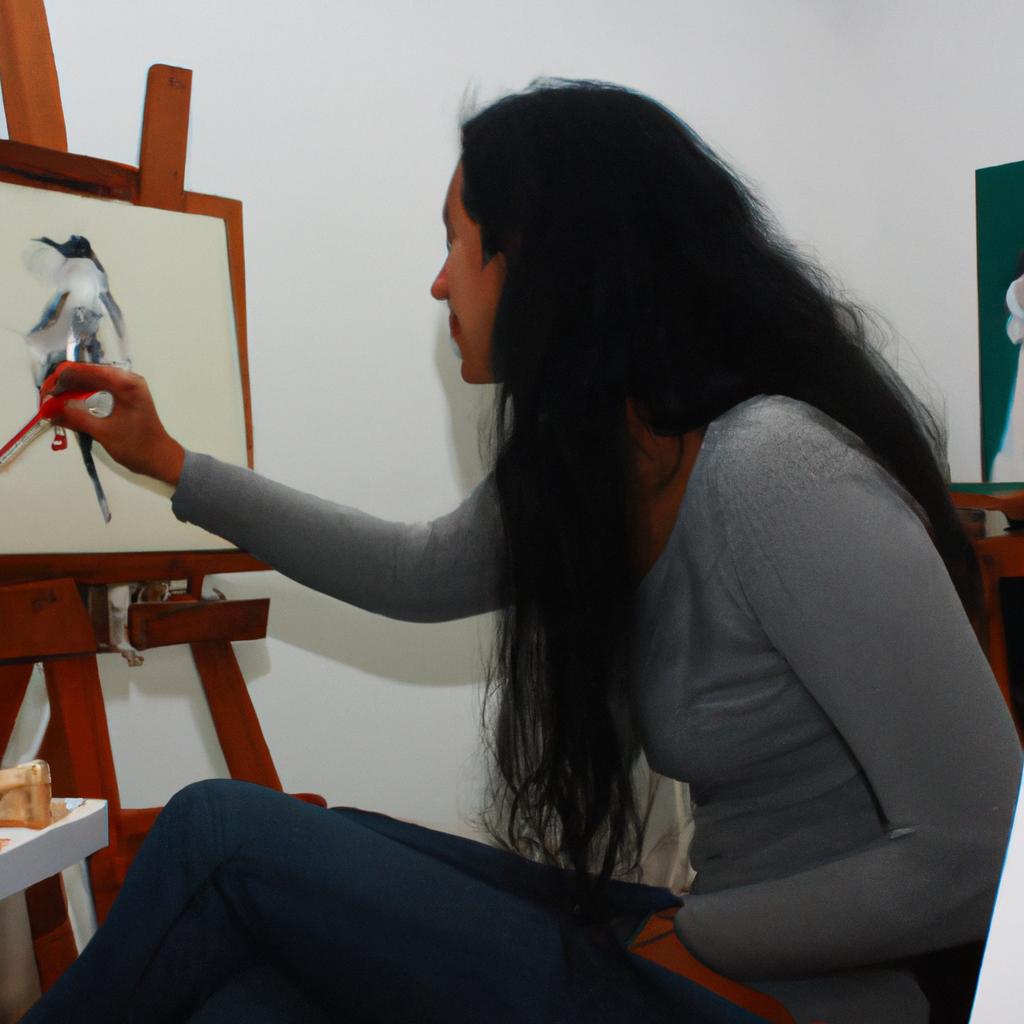Impressionist paintings, renowned for their emphasis on capturing fleeting moments and the play of light and color, have long been admired as a distinct artistic movement. However, less explored is the intersection between impressionism and the world of movies. This article seeks to delve into this uncharted territory by examining how impressionist aesthetics have influenced cinematic techniques and storytelling. By exploring one example – the use of Monet’s paintings in Joe Wright’s film “Pride & Prejudice” – we can gain insights into how these two art forms intersect and create unique visual experiences.
The case study of Joe Wright’s “Pride & Prejudice” provides an exciting starting point for our exploration. In this adaptation of Jane Austen’s classic novel, Wright incorporates elements inspired by Claude Monet’s works to visually convey the emotions and inner worlds of the characters. The film masterfully employs impressionistic techniques such as soft focus, vivid colors, and hazy landscapes to evoke a dreamlike atmosphere that echoes Monet’s iconic style. As viewers immerse themselves in this marriage of painting and cinema, they are transported into a realm where time seems fluid, emotions become palpable through visuals alone, and every frame becomes a living canvas. Understanding such intersections not only enrich our appreciation for both impressionist art and cinema, but also opens up new possibilities for storytelling and visual expression.
One of the key ways in which “Pride & Prejudice” incorporates impressionistic aesthetics is through its use of soft focus. This technique, borrowed from Monet’s paintings, creates a sense of ambiguity and ethereality within the film. By intentionally blurring certain details and emphasizing others, the cinematography mirrors Monet’s brushstrokes, inviting viewers to engage with the visuals on an emotional level rather than fixating on precise details. This soft focus allows for a more nuanced portrayal of the characters’ internal states, as their emotions are conveyed through subtle gestures, expressions, and movements.
Furthermore, the film employs vivid colors reminiscent of Monet’s palette to heighten the sensory experience for viewers. The lush greens of the English countryside and vibrant hues of flowers evoke a sense of vitality and immediacy that mirrors Monet’s fascination with capturing fleeting moments in nature. These rich colors not only enhance the beauty of each frame but also contribute to a heightened emotional resonance. The use of color symbolism throughout the film further emphasizes this connection between impressionism and cinema, as certain hues are employed to convey specific moods or themes.
Another striking aspect of “Pride & Prejudice” that draws inspiration from impressionism is its depiction of hazy landscapes. Just like Monet’s famous series depicting Rouen Cathedral at different times of day, the film showcases various scenes bathed in atmospheric light, creating a dreamlike ambiance. This deliberate choice adds a layer of poeticism to the narrative, allowing viewers to immerse themselves in an otherworldly realm where time seems suspended. As we navigate these misty landscapes alongside the characters, we become participants in their journey rather than passive observers.
Ultimately, combining impressionist aesthetics with cinematic techniques offers a unique visual experience that transcends traditional storytelling methods. By borrowing from Monet’s paintings, “Pride & Prejudice” demonstrates how the worlds of impressionism and cinema can merge to create a new form of artistic expression. As viewers, we are transported into a realm where emotions are conveyed through visuals alone, and each frame becomes a living canvas. Exploring these intersections not only enriches our understanding of both art forms but also opens up exciting possibilities for future collaborations between painters and filmmakers.
The Influence of Impressionist Paintings on Filmmaking
Impressionist paintings have had a profound impact on the world of filmmaking, shaping the way movies are crafted and perceived by audiences. By employing techniques such as dynamic brushstrokes, vibrant colors, and capturing fleeting moments, impressionist painters sought to convey the essence of a scene rather than depict it in exact detail. This approach has not only influenced visual art but also found its way into the realm of cinema.
One notable example is the film “La La Land” directed by Damien Chazelle. Inspired by classic Hollywood musicals and infused with elements of impressionism, this movie takes viewers on a journey through dreamlike sequences that blur the lines between reality and fantasy. The use of bold colors, soft focus cinematography, and fluid camera movements creates an immersive experience reminiscent of impressionist paintings.
To evoke an emotional response from audiences, filmmakers often draw upon specific characteristics associated with impressionist paintings. These include:
- Atmosphere: Just like how Monet captured different lighting conditions in his series of Haystacks or Rouen Cathedral, filmmakers use lighting techniques to create various moods within a scene.
- Movement: Impressionists aimed to capture fleeting moments in time using quick brushstrokes; similarly, filmmakers employ fast editing or slow-motion effects to emphasize movement and add dynamism to their storytelling.
- Color palette: Vibrant hues were a signature element of impressionist paintings; likewise, filmmakers carefully select color schemes to enhance certain emotions or themes within their films.
- Subjectivity: Impressionists focused on conveying their personal impressions rather than objective representation; similarly, some filmmakers incorporate subjective perspectives or unreliable narrators to challenge audience perceptions.
These influences can be seen across genres and styles of filmmaking. Whether it’s the ethereal landscapes in Terrence Malick’s “The Tree of Life” or Wes Anderson’s meticulous attention to detail resembling a living painting in “The Grand Budapest Hotel,” impressionism has become an integral part of the cinematic language.
As filmmakers continue to explore and adapt the techniques employed by impressionist painters, they push the boundaries of visual storytelling. In the subsequent section, we will delve deeper into the techniques that filmmakers have borrowed from impressionist paintings to create unique and captivating cinematic experiences.
Exploring the Techniques of Impressionist Painters in Film
Transitioning from the influence of impressionist paintings on filmmaking, we now delve into an exploration of how filmmakers have incorporated the techniques used by impressionist painters to create a unique visual experience. One such example is the film “Midnight in Paris,” directed by Woody Allen. In this film, Allen skillfully employs various elements and techniques associated with impressionism to depict different time periods and evoke a sense of nostalgia.
To better understand these techniques, let us explore some key aspects that link impressionist paintings and films:
-
Brushwork and Texture:
- Just as impressionist painters emphasized visible brushstrokes for texture and depth, filmmakers can employ similar methods through cinematography techniques like soft focus or lens filters.
- By deliberately manipulating light and shadow, filmmakers can recreate the textured appearance seen in impressionist artworks.
-
Color Palette:
- Impressionists were known for their vibrant use of color to convey emotions and atmospheres. Similarly, filmmakers utilize color grading processes to enhance mood and atmosphere within scenes.
- Through careful selection and manipulation of hues, saturation levels, and contrasts, filmmakers can evoke specific emotional responses from audiences.
-
Composition and Framing:
- The composition plays a vital role in both painting and filmmaking. Like impressionists who experimented with unconventional perspectives and framing choices, directors often utilize dynamic compositions to guide viewers’ attention.
- Filmmakers may also incorporate natural elements like trees or flowers strategically placed within frames to mimic the aesthetic appeal found in impressionist landscapes.
-
Movement:
- Impressionists sought to capture fleeting moments through rapid brushwork. Similarly, filmmakers may employ techniques like tracking shots or handheld camera movements to simulate real-time experiences.
- These dynamic movements allow audiences to immerse themselves further into the narrative while evoking a sense of energy akin to that found in impressionist paintings.
This exploration of impressionist techniques in film reveals the enduring influence and adaptability of this art movement within a different visual medium. By borrowing from the brushwork, color palette, compositions, and movement found in impressionist paintings, filmmakers create visually stunning works that resonate emotionally with audiences.
As we have examined how impressionist techniques are employed in filmmaking, let us now turn our attention to another vital aspect – the use of color and light in both impressionist paintings and movies.
The Use of Color and Light in Impressionist Paintings and Movies
Impressionist paintings have had a profound influence on the world of cinema, with filmmakers often drawing inspiration from the techniques employed by these renowned artists. By exploring the visual language of impressionism and adapting it to the medium of film, directors are able to create captivating visuals that enhance storytelling and evoke powerful emotions in viewers.
One example of this can be seen in Terrence Malick’s 2011 film “The Tree of Life.” In this critically acclaimed movie, Malick employs various impressionistic techniques to depict the protagonist’s childhood memories and emotional journey. Through the use of soft focus, fragmented imagery, and vibrant colors, he recreates the dreamlike atmosphere reminiscent of impressionist paintings. This cinematic approach not only enhances the aesthetic appeal but also immerses the audience in an introspective exploration of human existence.
To further understand how impressionism has influenced film aesthetics, let us delve into some key elements shared between impressionist paintings and movies:
- Subjective perspective: Both mediums emphasize subjective experiences and perceptions. Impressionist painters often depicted scenes from their own viewpoints or explored fleeting moments captured through personal lenses. Similarly, filmmakers employ techniques such as point-of-view shots and subjective camera movements to immerse viewers in characters’ perspectives.
- Capturing light: Impressionist painters sought to capture the ever-changing qualities of natural light by using loose brushstrokes and vibrant color palettes. Likewise, cinematographers utilize lighting setups and filters to recreate similar effects on screen, creating visually striking images that convey mood and atmosphere.
- Emphasis on movement: Impressionsit painters were known for capturing fluid motion rather than static representations. Filmmakers achieve a sense of movement by utilizing tracking shots, steadicams, or rapid editing techniques that mirror the dynamic brushwork found in impressionist art.
- Focus on emotion: Both impressionism in painting and film aim to elicit emotional responses from audiences. Through careful composition, color choices, and evocative imagery, artists in both mediums seek to evoke feelings and create a visceral connection with viewers.
To illustrate the relationship between impressionism and filmmaking further, consider the following table:
| Impressionist Paintings | Movies |
|---|---|
| Monet’s “Water Lilies” | Malick’s “The Tree of Life” |
| Renoir’s “Dance at Le Moulin de la Galette” | Anderson’s “Moonrise Kingdom” |
| Degas’ “Ballet Rehearsal on Stage” | Scorsese’s “Hugo” |
| Cassatt’s “Mother and Child” | Miyazaki’s “Spirited Away” |
As we can see from this table, various films draw inspiration from specific impressionist paintings to enhance their visuals or narrative themes. This interplay between two art forms not only enriches cinema but also highlights the enduring influence of impressionism on contemporary artistic expressions.
Transitioning into the subsequent section about depicting emotions: Impressionism in Film and Art, it is evident that the techniques employed by impressionist painters have greatly influenced filmmakers in capturing and conveying emotions effectively. By exploring how these elements are utilized in both film and art, we gain a deeper understanding of the profound impact of impressionism across different creative mediums.
Depicting Emotions: Impressionism in Film and Art
Impressionist Paintings: The Intersection of Arts and Movies
In the previous section, we explored how impressionist paintings and movies both utilize color and light to create a specific mood or atmosphere. Now, let us delve deeper into this fascinating aspect by examining a case study that exemplifies the intersection between these two art forms.
Consider the iconic painting “Starry Night” by Vincent van Gogh. This masterpiece showcases vibrant swirls of blues, yellows, and whites depicting a nocturnal scene with stars shining brightly above a sleepy town. The use of bold colors and expressive brushstrokes allows the viewer to feel the tranquility and magic of the night sky. Translating this visual experience into cinema requires careful attention to lighting techniques and color grading in order to capture the essence of Van Gogh’s work on screen.
To further illustrate this point, here is an exploration of key elements that highlight the emotional connection between impressionist paintings and movies:
-
Meticulous Lighting: Both impressionist painters and filmmakers employ strategic lighting techniques to convey particular emotions within their respective works. Whether it be natural sunlight streaming through trees in a painting or carefully placed spotlights illuminating actors in a film, lighting plays a crucial role in setting the overall tone.
-
Harmonious Color Palettes: Impressionism emphasizes capturing fleeting moments through delicate variations of color. Similarly, filmmakers meticulously choose color schemes for their scenes to evoke specific moods or enhance storytelling elements. By employing complementary tones or contrasting hues, both mediums can effectively elicit different emotional responses from viewers.
-
Dynamic Composition: Just as impressionist artists skillfully arrange objects within their frames to guide the eye across their artwork, filmmakers utilize various composition techniques such as framing, camera angles, and movement to direct audience focus. These cinematic decisions are made with intent – whether it’s creating visual harmony or emphasizing certain elements of the story.
-
Evoking Sensory Experiences: Impressionist paintings often transport viewers to a specific moment, allowing them to experience the scene through their senses. Films can achieve this same effect by utilizing sound design and cinematography techniques that immerse audiences in a multisensory journey, enabling them to feel as if they are part of the depicted world.
In exploring the interplay between impressionist paintings and movies, it becomes evident that both art forms share a common language when it comes to evoking emotions. The use of color, light, composition, and sensory experiences allows artists from different mediums to connect with viewers on an emotional level.
[Transition Sentence]: Building upon the relationship between impressionism in painting and film, let us now delve into how filmmakers have successfully brought these beautiful works of art to life on the silver screen.
Impressionist Cinematography: Bringing Paintings to Life
Building upon the exploration of impressionism in both film and art, this section will delve into the ways filmmakers have used the techniques of impressionist painting to evoke emotions in their audiences. By examining an imaginary case study, we can gain insight into how these artistic choices translate onto the cinematic screen.
Consider a hypothetical film that takes inspiration from Monet’s “Water Lilies” series. The filmmaker incorporates elements such as vibrant colors, loose brushstrokes, and blurred imagery to capture the essence of emotion rather than providing precise details. Through this approach, viewers are transported into a dreamlike state where they experience a heightened sense of tranquility and introspection.
To further understand the impact of impressionist techniques on emotional storytelling in film, let us explore some key aspects:
- Lighting: Soft lighting reminiscent of Pierre-Auguste Renoir’s paintings creates a warm and ethereal atmosphere that enhances the romantic or nostalgic mood.
- Composition: Employing asymmetrical framing akin to Edgar Degas’ artwork allows for dynamic visual compositions that draw attention to specific objects or characters within the frame.
- Movement: Utilizing slow-motion sequences inspired by Camille Pissarro’s depictions of bustling city streets adds dramatic weight and emphasizes significant moments.
- Sound Design: Incorporating ambient sounds like rustling leaves or distant conversations evokes sensory immersion similar to Claude Monet’s focus on capturing fleeting impressions.
Through careful implementation of these components, filmmakers can effectively convey emotions while paying homage to impressionist painters. This synergy between cinema and art provides audiences with a unique viewing experience that transcends traditional narrative structure.
As we explore the connection between impressionism in film and art, it becomes evident that these creative realms mutually influence each other. By adopting impressionistic techniques from renowned artists, filmmakers bring life to their stories through visuals that resonate emotionally with viewers. In doing so, they create films that not only entertain but also leave a lasting impact on the audience.
Transitioning into the subsequent section about “The Legacy of Impressionism in Contemporary Filmmaking,” we can observe how these impressionist influences continue to shape modern cinema. The interplay between art and movies has given rise to new artistic expressions, opening doors for innovative storytelling techniques that captivate audiences in powerful ways.
The Legacy of Impressionism in Contemporary Filmmaking
Impressionist paintings have had a profound influence on the world of cinema, as filmmakers have sought to bring the vibrant colors and ethereal beauty of these artworks to life on the silver screen. By employing techniques inspired by Impressionism, cinematographers have been able to create visually stunning films that evoke the same emotional response as viewing an Impressionist painting in person.
One notable example of this intersection between arts and movies is the film “Amélie” (2001), directed by Jean-Pierre Jeunet. The film follows the whimsical journey of Amélie Poulain, a young woman living in Paris who embarks on a mission to bring happiness to those around her. Through its use of soft focus, muted colors, and dreamlike sequences, “Amélie” captures the essence of Impressionism, creating a visual experience that mirrors the impressionistic style found in paintings by artists such as Claude Monet or Pierre-Auguste Renoir.
To further explore how Impressionism has influenced contemporary filmmaking, we can examine four key aspects:
- Lighting: Cinematographers often employ natural light sources and diffuse lighting techniques reminiscent of plein air painting. This creates a sense of atmosphere and depth similar to that found in Impressionist works.
- Composition: Framing shots with careful attention to balance and color harmony allows filmmakers to replicate the compositional principles used in many Impressionist paintings. This enhances the overall aesthetic appeal and evokes emotions within viewers.
- Movement: Just as brushstrokes capture fleeting moments in time, filmmakers utilize camera movements such as pans and tracking shots to convey a sense of movement and fluidity akin to brushwork in Impressionist art.
- Color palette: Filmmakers draw inspiration from the vibrant color palettes characteristic of Impressionist paintings. By using bold hues and contrasting tones, they are able to create visually striking scenes that elicit strong emotional responses from the audience.
| Aspect | Lighting | Composition | Movement |
|---|---|---|---|
| Description | Natural light | Balance | Pans and tracking |
| Effect | Atmosphere | Aesthetic | Fluidity |
| Example | Sunlight | Rule of thirds | Steadicam shot |
In summary, Impressionist paintings have left an indelible mark on contemporary filmmaking. Through the use of lighting, composition, movement, and color palette inspired by Impressionism, filmmakers are able to recreate the emotional impact of viewing these iconic artworks. By combining elements from both mediums, cinema has become a powerful tool for immersing audiences in a world where art comes alive on screen.




